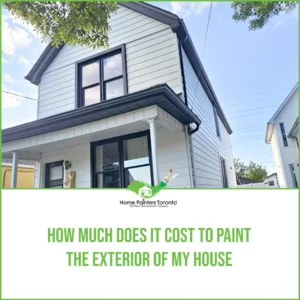
Sometimes, we look at our homes and long for the good old days when we were young, ready to take on the world. After a while, our houses start to reveal the same wear and tear that our busy lives create in us. So once in a while, doing a refreshing DIY painting basics project can bring back your home’s vibrancy.
Here are some steps to painting the exterior of your home.
1. Start with an Exterior House Wash
It is important that you spend some time washing the dirt and grime off of the outside of your house before you start DIY painting. If the exterior surface of your house is free of paint-repelling soil, the primer and paint will adhere better. Creating a long-lasting appearance of your home.
Most of the time, a simple wash with a hose, a pump sprayer and a scrub brush is sufficient. But if you decide that you would prefer a professional to help you, a power washer in the hands of a professional can provide a superior clean.
We don’t recommend that you try to use a power washer on your own unless you are very familiar with it because it can cause damage to house wood siding and house trim if used incorrectly.
2. Prepare Your House For Painting
Before you paint the exterior of your house in Toronto, you should scrape off any bubbling or blistering paint that could cause future problems for your DIY painting project.
Note: Beware of lead paint! Some houses that were built before 1978 have paint on them that may contain traces of lead paint. Exposure to lead paint can cause anemia, learning disabilities in children, and damage to the brain and nervous system. When working on the exterior of your historic home (older than 1960) be sure that you observe the proper safety measures, including:
Wearing an inhalator
Wear proper gloves
Protecting your eyes with safety goggles
3. Sand the Area Where You Would Like to Paint
The goal when DIY painting the exterior of your house in Toronto is to have the cleanest and most beautiful exterior you can. Sanding will help by smoothing out any bumps or lumps that can look strange under a fresh coat (or 2) of paint. Recommendations for sanders:
- Random Orbit Sander
- Pad sander
4. Patch and Fill Holes
The goal here is to repair any damage that could worsen over time, requiring an unnecessary future DIY painting of your home.
You can remedy little holes in siding with an exterior patching substance, readily available in a premixed type. In a dry powder type, you have to mix it with water. Ensure durability by looking at the packages that state that the patching compound is for exterior use.
To patch holes in the siding of any kind, simply clean the hole that you plan to fill with the compound. Smoothen the area you wish to spot with 80-grit sandpaper for a better result. After doing so, fill the space with the exterior patching compound. Apply the compound to the hole in one direction. Smooth it in a vertical stroke to level with the initial surface area. Then wait for the compound to solidify, and after that, smooth it out. The mixture diminishes, so another coat might be required. Ensure to eliminate the dust from sanding the compound prior to another coat.
This way, painting the exterior house with a roller would be easy, as there would be no debris sticking to the rollers after all the patching and sealing.
On the contrary,
Remove any decaying wood with a sculpt to repair large fractures and damaged trim to avoid unsightly painted house exterior visualizers. Be sure that you repair any rotten wood, fix any dents and replace damaged pieces of your home that might get worse in the future.
Use a two-part polyester-based substance to make the repair work successful, perfect for house painting DIY as well. Two-part fillers come with a thick paste base and a little tube of hardener substance. Mix the hardener substance with the paste according to the product’s manual. The filler will be set within five minutes, so better mix only what you can use immediately and make sure to clean your tools right away after use. This is also to avoid catastrophe on painting outside of house colours by not knowing this matter.
Make use of a putty knife to apply the compound to the problem area and level it with the surface before painting the exterior walls for the first time. This filler doesn’t shrink when painting over old exterior paint as much as premixed exterior fillers do. However, you may still need to use several coats to fill a larger hole. After the filler solidifies, it can now be subjected to drilling and sanding.
Two-part polyester-resin fillers
It can be used for aluminum siding using the same method. However, before applying the filler, the exterior wall painting process must be followed step by step, and how to seal a house before painting must be followed first. Thus, drill numerous 1/8-inch-diameter holes in the spot. When you use the substance, it locks into the holes for a better bond and solidification. You can also cover the damage with a new piece of siding. To do so, cut the top flange off in order for the patch to fit under the course above. And embeds it in adhesive caulk along the top and side edges.
5. Caulk and Seal (Any Windows or Openings to Prevent Air and Water From Leaking In)
This may be the most important part of the Exterior House Painting Process. It’s important to have a well-maintained, beautified, non-rotting wood house, but it’s just as important to make sure the windows, cracks, and openings aren’t leaking air or letting in water which can ruin the interior of your house.
Depending on the severity of the deterioration, you can even resort to heavy-duty, professional-grade, industrial caulking. See the exterior caulking page. Painting the exterior of your Toronto home is a lot of work, can be very messy if you aren’t careful, and potentially dangerous as well if dealing with ladders. It is important to consider protecting your landscaping and cars when doing DIY painting. You don’t want to get paint all over your bushes (or your brand-new car!).
Most hardware stores and paint stores carry plastic paint sheets that you can use to protect any surface from getting covered in paint.
While professional painters sometimes use paint sprayers for external house painting (because it is faster and may provide a more even appearance than by hand), it can be very messy in the hands of a novice sprayer. You may find that without proper training, paint sprayers can cause more damage than good, so leave them to the professionals if possible.
Painting the Exterior: Exterior House Painting Tips from Home Painters Toronto
- Start at the top of your house and work your way down. This serves two purposes;
First, it allows you to go down the ladder instead of up as you work. Preventing potentially life-threatening falls. Also, when prepping/scraping the paint off, you will have debris falling on the bottom areas that you just painted.
Second, painting from top to bottom prevents messy drips and missed spots, Ideally, you should also start painting from the left side and work your way right because you are more likely to see any missed spots
- Don’t start painting if it might rain. While latex paint is fairly steadfast once it’s dried, a good rain while it’s wet, can wash the paint away. It’s better to wait until the rain is no longer in the forecast than to try to paint on a rainy day and have to start all over again later.
Professional Home Painters Toronto Tip
- Follow the shade. When you DIY paint the exterior of your home, you would be wise to follow the shade from your house and avoid the sun. As the sun moves around your house, try to avoid the sun as much as possible because you may become overheated by the sun beating down on you, and painting in direct sunlight depending on the heat of the day is not good for the application process and can cause bubbling/adhesion issues. For example, it’s sunny in the morning on the east side of the house, so paint on the west side of the house.
- Prevent dehydration and dizziness by eating properly, drinking lots of water, and staying in the shade during the hotter parts of the day while painting the exterior of your house.
- Use a paintbrush for better control and precision. As we mentioned earlier, paint sprayers can be messy in an unpracticed hand. Alternatively, you could use a mini-roller to go along your siding a little quicker. Except for siding, brick, and large doors, try to avoid using rollers as they don’t cover as well, and harder to be precise than using a paintbrush.
When to Call in the Pros
Sometimes, despite your best efforts, the scope of the project or the challenges you face exceed the DIY sphere. Here are signs that it might be time to call for reinforcements:
- The scale of your home is too large or too high to safely manage on your own
- You lack the time or resources to adequately prepare or execute the project
- You’ve uncovered issues during the inspection phase that require professional expertise
- The project requires specialized techniques or equipment that you don’t have access to.
Calling in a professional painter may seem like a last resort, but in many cases, it is the wisest decision. It can save you time, money, and the headache of fixing a botched DIY job later on.
The Benefits of Hiring a Professional for Exterior Painting
Hiring a painting contractor for your home’s exterior can bring a multitude of advantages that go beyond the simple application of paint. It’s an investment in your home’s future, ensuring that the job is done right, with careful attention to detail, and with products that are built to last.
Quality and Efficiency
A professional painter understands the nuances of different surfaces and how to treat them, ensuring that the paint adheres properly and lasts longer. They come equipped with the right tools and techniques to execute the job efficiently, finishing in a fraction of the time it might take a DIY enthusiast, without sacrificing quality.
Safety
Working on the exterior of a home, especially multi-story buildings, poses various safety risks, including falls. Professionals are trained in safety protocols and use proper equipment to mitigate these risks.
Preparation and Clean-Up
A significant part of a professional’s job involves preparing the surface for painting and cleaning up afterward. This includes power washing, sanding, and dealing with mould or mildew, tasks that are often underestimated in terms of time and effort by homeowners.
Access to High-Quality Materials
Professional painters have access to high-grade, durable paints and materials that might not be readily available to the general public. They have the knowledge to select the best materials for your specific project, ensuring a finish that looks better and lasts longer.
Warranty and Peace of Mind
Many professional painting services offer warranties on their work, giving you peace of mind knowing that should any issues arise from the job, they will be rectified without additional charges to you.
Enhancing Property Value
A well-executed exterior paint job not only beautifies your property but can also significantly increase its value. Professionals understand the exterior house paint colour trends and application techniques that can make your home stand out in the neighbourhood, appealing to potential buyers.
In the end, while DIY projects can be rewarding, the complexity and scale of exterior painting often mean that hiring a professional is the most prudent choice. It ensures a high-quality finish that benefits your home’s appearance, durability, and value.
More TESTIMONIALS Related to
“DIY Painting Basics: Painting The Exterior of Your House”
If you reside in Toronto and the GTA and need some help figuring out the exterior painting costs per square foot, don’t hesitate to call us! We will help you pick the colours you want and show you the latest painting and home renovation trends. Our home painting services with the best pro painters have been around now for over 36 years.
Call 416.494.9095 or email Brian@HomePaintersToronto.com for a FREE quote for your home painting needs. And don’t forget to check us out on our social media channels below!





